|
ProModeler's 1/32 Scale
Conversion
Messerschmitt
Bf
109G-2/Trop
by
Ian Robertson
|
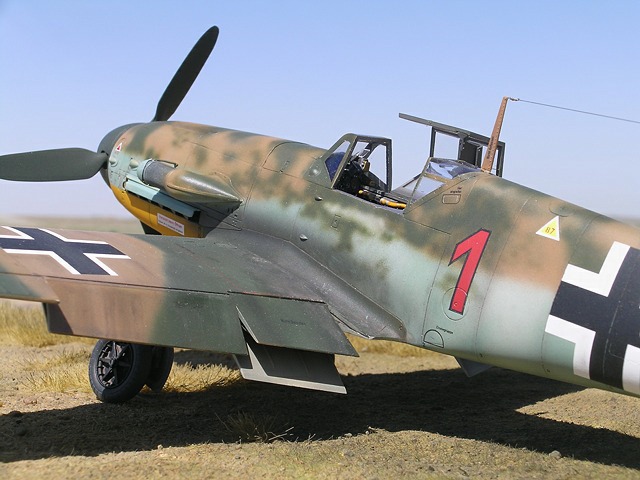 |
|
Messerschmitt Bf 109G-2/Trop |

ProModeler's
1/32 scale Messerschmitt Bf 109G-4
is available online from Squadron.com
This model depicts “Red 1”, a tropical Bf.109G-2
flown by Werner Schroer of 8./JG27, Rhodes Island (Greece), in early
February 1943. It is based on Pro-Modeller’s 1/32 Bf.109G-4 trop kit.
Backdating a
Bf 109G-4 to a G-2
|
Backdating the Bf.109G-4 trop into a G-2 trop is a
relatively simple procedure. I replaced the kit’s main tires with a
narrower style of tire produced by Aires for their Bf.109F conversion
(the F tire is appropriate for the G-2, and can be purchased from Aires
as part of the F conversion set or on its own). According to Prien and
Rodeike (Messerschmitt Bf109 F,G, and K Series. Schiffer
Publishing), the orientation of the G-2 tire is different than that of
the G-4 and later variants. Specifically, the G-2’s tire is positioned
more-or-less parallel with the landing strut, whereas in the G-4 and
later variants the tire sat slightly more vertical. Also note that,
with the narrower tire, the teardrop-shaped fairing on the upper surface
of each wing should be deleted.
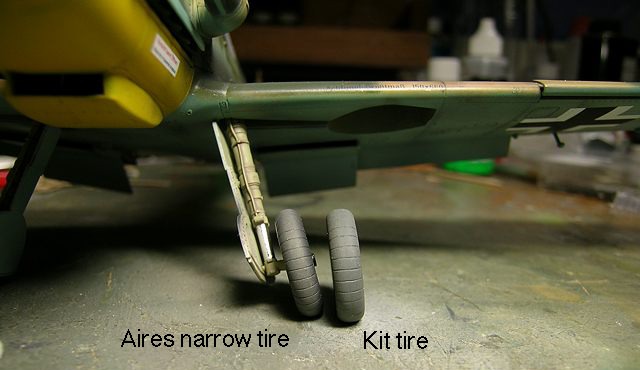
I
replaced the kit’s tail wheel assembly with Cutting Edge’s tail wheel
and yoke. Cutting Edge’s wheel is slightly smaller in diameter than the
kit’s wheel. The replacement wheel assembly was modified by removing
the dust cover and adding a piece of rigid wire for the strut. Although
most G-2s had retractable tail wheels, in-flight photographs show that
Schroer’s aircraft had the tail wheel locked down and the wheel well
covered. Therefore, it was not necessary to open the wheel well on my
model
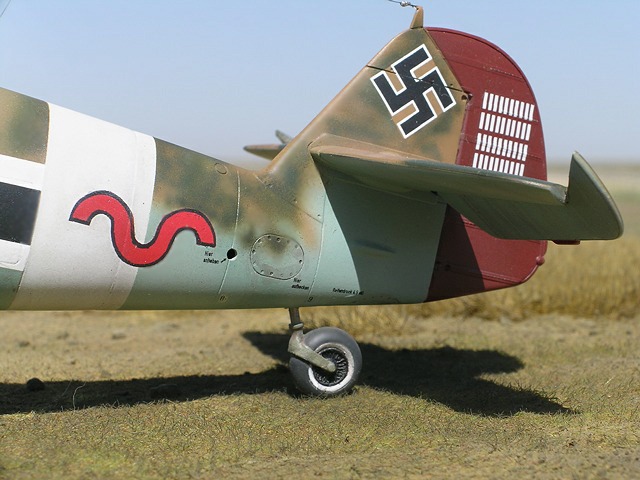
The
position of the fuselage antenna lead-in was different between the G-2
and G-4 due to the use of different radio equipment. Specifically, the
antennae lead-in on the G-2 entered on panel 5 rather than panel 7. The
antenna wire on my model was constructed from stretched sprue. “Tension
springs” were added to each end of the antenna wire by threading the
stretched sprue through small pieces of coiled filament from an
incandescent light bulb. A drop of CA glue held the filament in place.
The same technique was used on the wire that secured the open canopy.

Other additions
to the model
The single biggest
enhancement to my model was the use of MDC’s Bf.109G-2/4 cockpit.
Although the kit’s cockpit is relatively competent in design and detail,
the superb detail and craftsmanship of the MDC cockpit is definitely
worthy of consideration, particularly if the cockpit is displayed open.
The cockpit area was painted in Polly Scale RLM 66 and then subjected to
numerous washes of raw sienna and burnt umber. Details were picked-out
with drybrushing and a silver pencil.
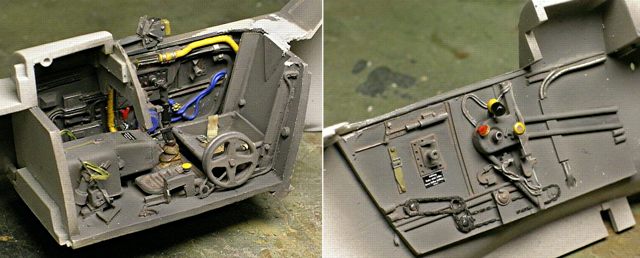
Other replacement
items on the model included Cutting Edge exhausts, tropical filter, and
elevators. Because the kit’s spinner is noticeably bulbous, I replaced
it with a resin spinner from Eagle Editions (note that MDC also makes a
suitable replacement).
Red 1’s Camouflage Scheme
Looking through my references I was surprised to
find four different color profiles of Schroer’s G-2, all of which
depicted the aircraft while it was stationed at Rhodes in February
1943.
Two of the references showed the aircraft in a
standard European scheme of RLM 74/75/76, and two showed the aircraft in
desert camouflage of RLM 78/79 with patches of dark green (RLM 80 or
dark Italian green).
The differences did not end there - below is a
table summarizing the most notable differences between the profiles and
how they relate to a pair of photographs published in Roba and Pegg’s
“Jagdwaffe Volume 4, Section 2” (pg 168). Note that my comparison is
not intended as a criticism of the various sources - the artists who
produced the profiles may have had different reference photos available,
or they may have interpreted the same photographs differently.
|
Source
(see below
for complete reference) |
Camouflage Scheme |
White Lower Wingtips? |
Spinner |
Comparison with photos in Jagdwaffe Vol. 4, Section 2 (pg
168) |
|
Osprey
Bf109 Aces of North Africa |
·
RLM 74/75/76
·
red numbers and
rudder
·
no yellow on cowl |
No |
all white? |
·
tail wheel should
be down with wheel well covered
·
kill markings on
rudder are oversized in profile
·
rudder should not
be same color as fuselage markings |
|
Histoire &
Collections Me109 Vol 2 |
·
RLM 74/75/76
·
red numbers and
red or red oxide rudder
·
no yellow on cowl |
No |
all white? |
·
kill markings on
rudder are oversized in profile
·
incorrect position
of fuselage antenna lead-in (panel 7 rather than 5)
·
incorrect position
and style of first aid symbol on access panel |
|
More
Luftwaffe Fighter Aircraft in Profile |
·
RLM 78/79 with
green patches
·
reddish brown
numbers and rudder
·
yellow on lower
cowl |
No |
2/3 RLM 70
1/3 white |
·
rudder should not
be same color as fuselage markings |
|
Jagdwaffe
Vol 4 Section 2 |
·
RLM 78/79 with
dark green patches
·
red numbers and
red oxide rudder
·
yellow on lower
cowl |
Yes |
2/3 RLM 70
1/3 white |
·
white wingtips
difficult to discern in photographs. Perhaps visible in
starboard image. |
Scutts. 1994. Bf.109 Aces of North
Africa and the Mediterranean. Osprey Publishing (profile 31 on pg
43 - profile by Mike Chappell) .
Breffort and Jouineau. 2002.
Messerschmitt Me 109 Vol. II. Histoire & Collections (profile 3 on
pg 40).
Sundin and Bergstrom. 2002. More
Luftwaffe Fighter Aircraft in Profile. Schiffer Publishing (profile
67 on pg 79 - profile by Claus Sundin).
Roba and Pegg. 2004. Jagdwaffe Vol
4 Section 2: The Mediterranean 1942-1943. Classic Publications (pg
168 - profile by Tom Tullis).
I opted to follow most closely Tom Tullis’ profile
in the Jagdwaffe book because the details seemed to match the supporting
photographs best. This photograph of my model gives the view closest to
the profile.

It is worth noting that another photograph of “Red
1” in Osprey’s Aces book (pg 68) does not show the dark patches on the
fuselage that seem so obvious in the Jagdwaffe book. Perhaps patches of
green were applied in the field at a later date than the Osprey photo.
Another uncertainty I had concerned the style of
the upper wing crosses. In the Osprey photograph the cross appears as a
white outline only. To me this would favor the RLM 74/75/76
interpretation of the camouflage. However, the demarcation between
upper and lower camouflage on the fuselage appears to me more like RLM
78/79 than RLM 74/75/76. In the Jagdwaffe book there are photos of
other 8./JG27 aircraft (albeit earlier Bf.109Fs) at Rhodes Island in
desert camouflage with black-filled wing crosses, so I opted for
black-filled crosses on my model. Although I found no clear
photographic documentation for the upper wings of Red 1, I added a green
splinter scheme to be consistent with the fuselage camouflage.
Painting and Marking Red 1
 There
are no decals available for this particular aircraft. In such instances
one can usually scavenge numbers and unit markings from other decal
sheets. Unfortunately, the red “1” on Schroer’s aircraft was in a style
I could not find elsewhere. Although the red wavy bar with black
outline was available on EagleCals sheet #32-39, I decided to paint both
the red markings so that the colors would remain uniform. There
are no decals available for this particular aircraft. In such instances
one can usually scavenge numbers and unit markings from other decal
sheets. Unfortunately, the red “1” on Schroer’s aircraft was in a style
I could not find elsewhere. Although the red wavy bar with black
outline was available on EagleCals sheet #32-39, I decided to paint both
the red markings so that the colors would remain uniform.
I began by cutting templates from Tamiya tape and
positioning them on the model. The templates were based on scaled-up
photocopies of the aircraft’s profile in the Jagdwaffe book. With the
template in place, I sprayed the base color of RLM 23 (red) using Polly
Scale acrylic. Once dry, a smaller mask was placed in the center of
each marking before spraying the black outlines. The entire markings
(red plus black outlines) were then masked until all painting was
complete.

The white fuselage band was painted and masked
prior to the addition of camouflage.
The model’s camouflage was painted with a
combination of Polly Scale acrylic (RLM 78/79) and Tamiya acrylic (XF-58
“olive green”). The national markings and stencils were scavenged from
various EagleCals sheets.
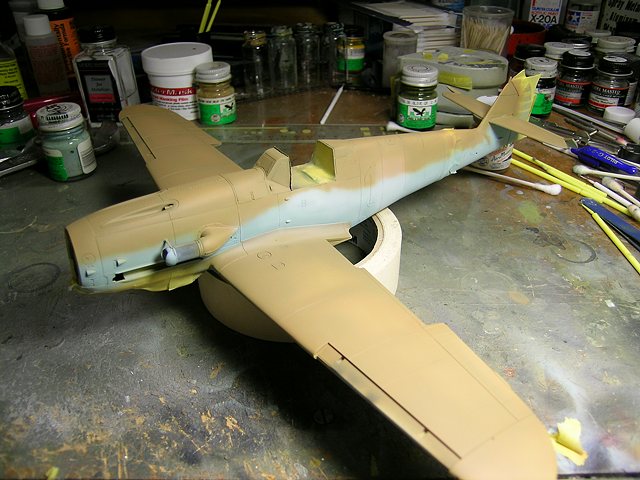
The rudder was painted Model Master acryl
“anti-fouling red”. While some photographs support the notion that the
rudders on some Bf.190 trops were very dark (some people have even
suggested black), others show them to be lighter than the interior of
the swastika (i.e., not black). In addition, contrary to the color
profiles in “Osprey Aces” and “More Luftwaffe Fighter Aircraft in
Profile”, the rudder on Red 1 was not the same color as the fuselage
markings, at least according to a photograph in the Jagdwaffe book.
Therefore, I opted for the traditional red oxide interpretation for the
rudder, and brighter red for the fuselage markings. The white kill
markings were adapted from EagleCals #32-64. They are slightly
oversized for this particular aircraft, but close enough.
Images were taken with a Nikon Coolpix 5400 digital
camera. The “sharpen edges” tool of Adobe Photoshop was used to restore
some of the clarity and crispness lost during image compression.
\
Interpretations of Luftwaffe camouflage evolve as
opinions change and more information comes to light. Thus, my
interpretations of camouflage and markings for Schroer’s aircraft may
not be correct. However, I’m not one to be paralyzed by lack of
definitive evidence and explanation - I look at the references I have
available, ask questions when necessary (Plane Talking is great for
this), then build, paint, and move on. If new information proves my
interpretation wrong, I can always tackle the project again. Besides, I
enjoy seeing how other modelers interpret the same subjects.
Click on the thumbnails
below to view larger images:
Messerschmitt Bf 109
Modelling Manuals 17 |
|
|
|
|
US Price: $17.95
UK Price: £12.99
Publisher:
Osprey Publishing
Publish Date:
January 25, 2002
Details: 64 pages; ISBN: 1841762652 |
|
|
Model, Images and Text Copyright ©
2004 by Ian Robertson
Page Created 23 June, 2004
Last Updated 22 June, 2004
Back to HyperScale
Main Page
|
Home
| What's New |
Features |
Gallery |
Reviews |
Reference |
Forum |
Search